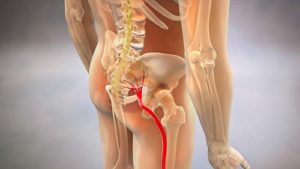
Everyone has 2 sciatic nerves- 1 on the right side of the body and 1 on the left side of the body. It is the longest nerve in the body. Many people do not realize that the sciatic nerves are actually made up of a combination of 5 lumbar (L) and sacral (S) nerves. These nerves are the L4, L5, S1, S2, and S3. The nerves combine in a single nerve sheath that extends into the buttocks and down the backs of the thighs to the back of the knees where it splits into 2 nerves in the back of the lower legs and into the feet making it the largest (longest and widest) nerve in the body.
These nerves control the hamstrings, calf muscles and foot muscles. These muscles are responsible for bending the knee, curling and extending the toes, and moving the ankle. The sciatic nerve also provides feeling to the skin of the skin of the outer lower leg and the foot.
Pressure on the L4, L5, SI, S2 and S3 nerves from vertebral misalignment, muscle spasms, bulged or herniated discs, and arthritic changes in the bones and ligaments can cause symptoms of sciatica. Pregnancy is also a common cause of sciatic pain. Common symptoms include pain from the low back into the back of the thigh and down the leg past the knee. The pain is often described as burning, tingling, or numbness. Sitting, standing, and walking can be painful when suffering from sciatica. It may be difficult to find a position that gives relief from the pain.
Sciatica is diagnosed by a combination of history of the symptoms and orthopedic testing. MRI can help to reveal the why the sciatic nerve is irritated and the extent of arthritic changes and tissue damage (bulged disc versus a herniated disc.
Conservative care, or non-invasive, drug-free treatments of sciatica include chiropractic adjustments, strengthening of the low back, abdominal and gluteal muscles, soft tissue therapy such as stretching, trigger point therapy, and cupping.
Medications such as anti-inflammatory drugs are also commonly used. Occasionally, a consult with a neurosurgeon may be necessary if the sciatica symptoms do not respond to conservative care.
Piriformis Syndrome is often mistaken for sciatica. The piriformis muscle is a large muscle located in each buttock. It attaches to the pelvis and the hip in order to rotate the hip outward. When the piriformis muscle is too tight it can put pressure on the sciatic nerve and is passes through the buttock region which cause symptoms that mirror symptoms of sciatica. Trauma to the piriformis muscle is one cause of piriformis syndrome but more frequently over-use (certain sports or exercises) and improper postures (sitting with the legs crossed) are more common causes of piriformis syndrome. Chiropractic adjustments to the pelvic bones, stretching the piriformis and strengthening the gluteals are effective treatments for piriformis syndrome.
Sciatica and piriformis syndrome often do not go away quickly. It frequently takes multiple chiropractic treatments over the course of several weeks to get lasting improvement. This is because nerves are the slowest healing tissues in the body.
If you have questions about how our team at One Goal Wellness can help you, please schedule a consultation today.


